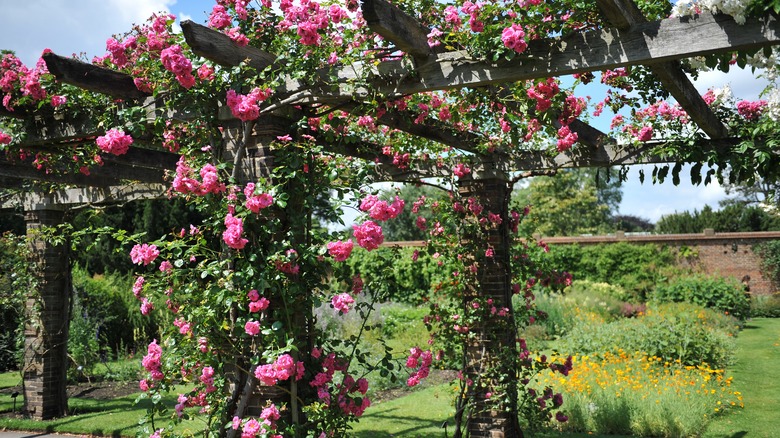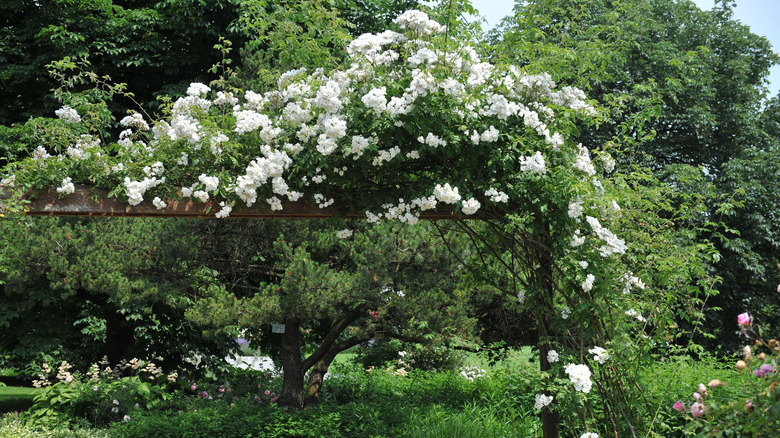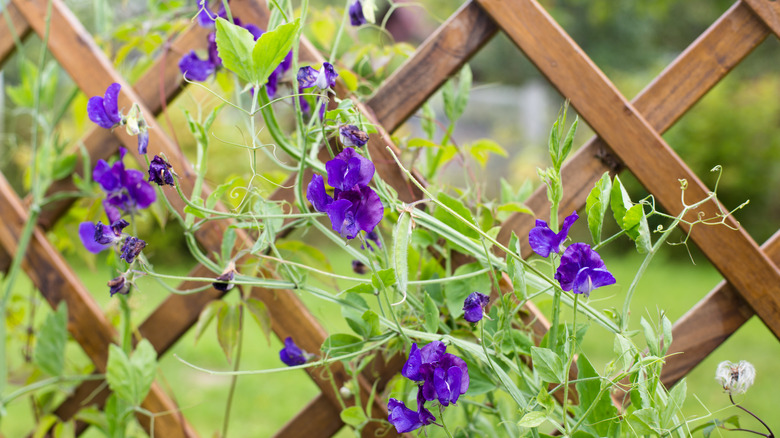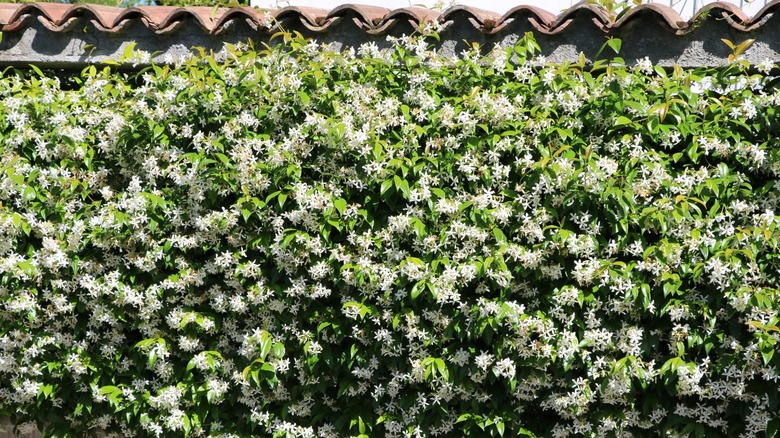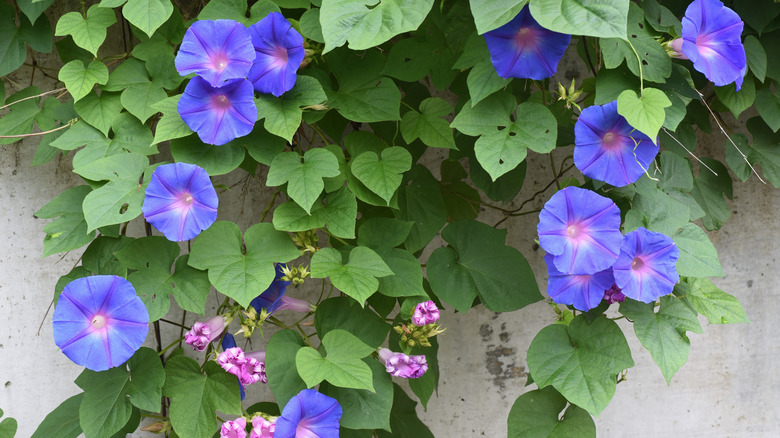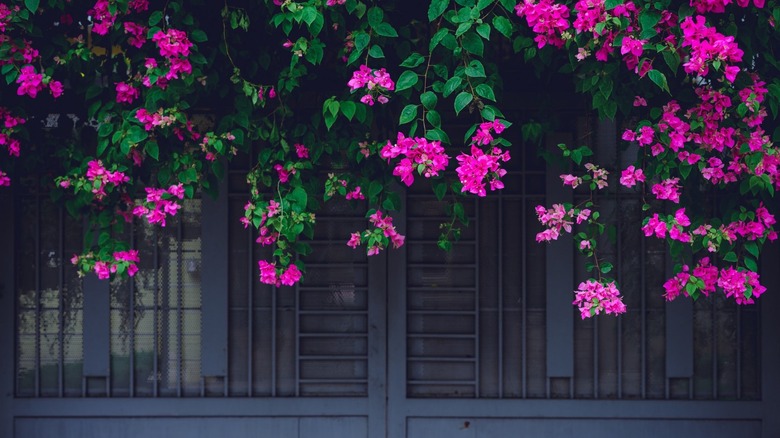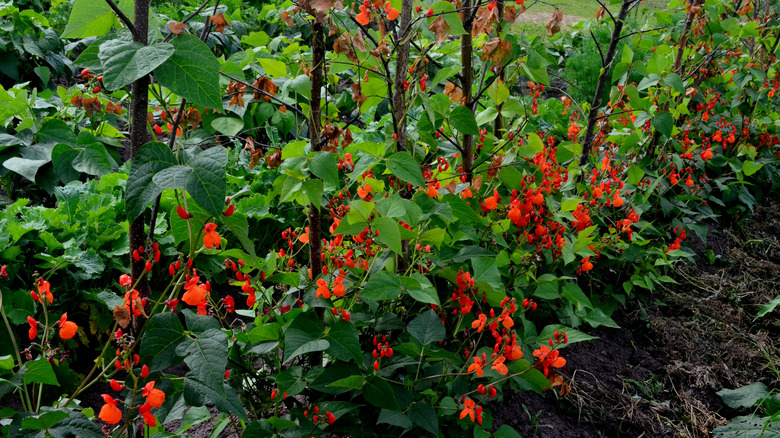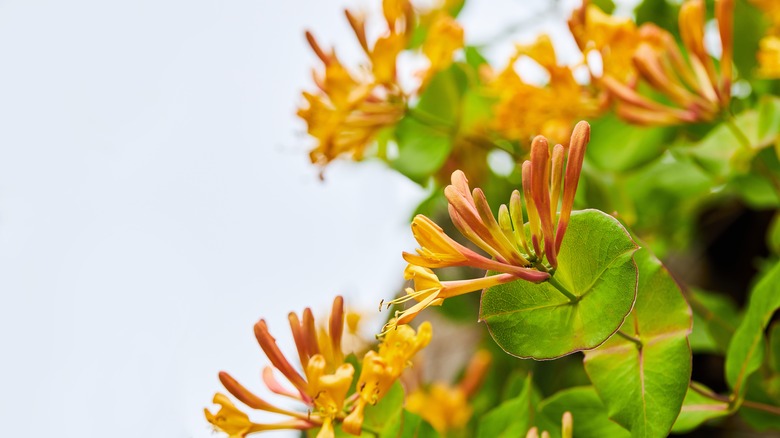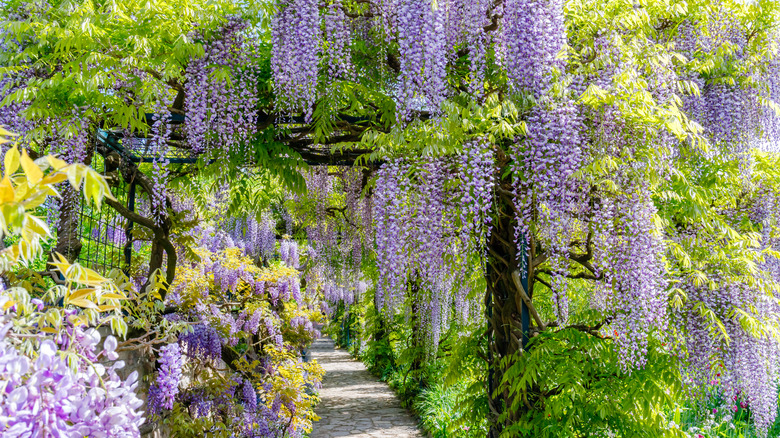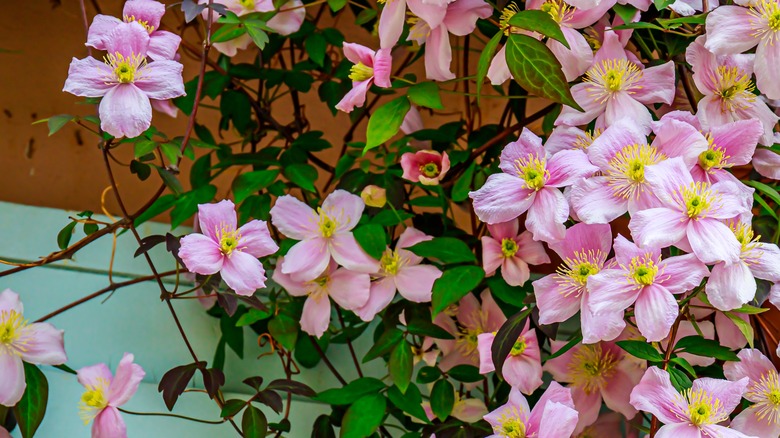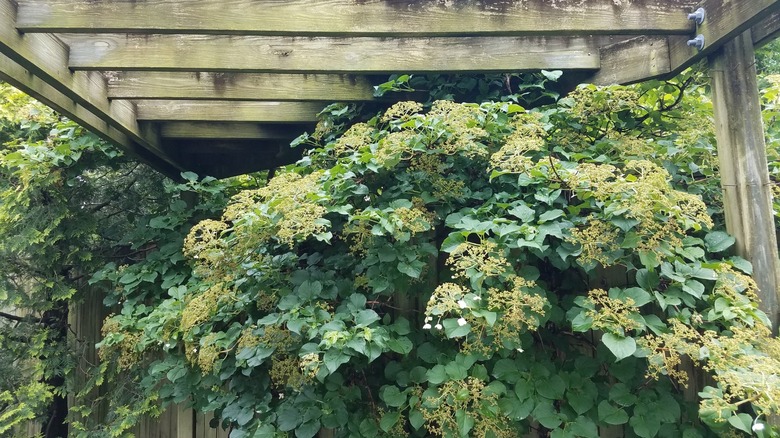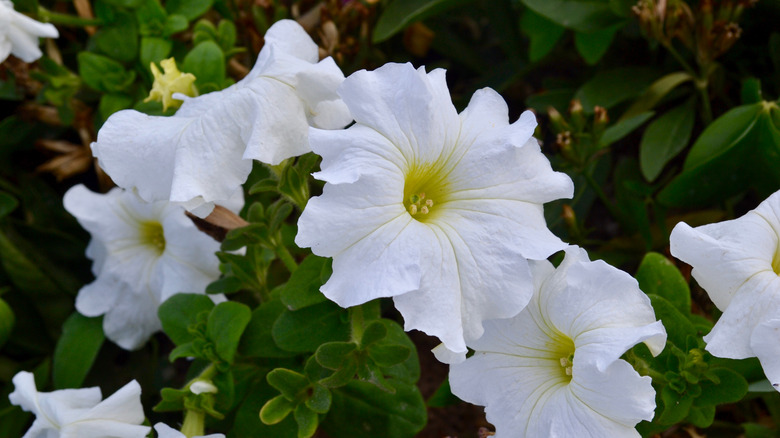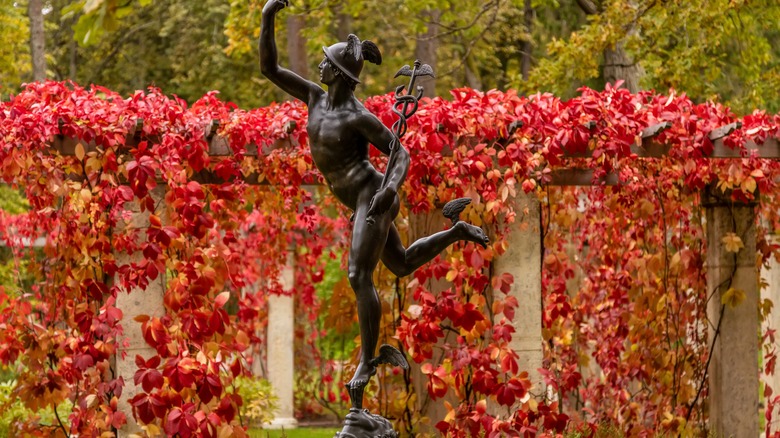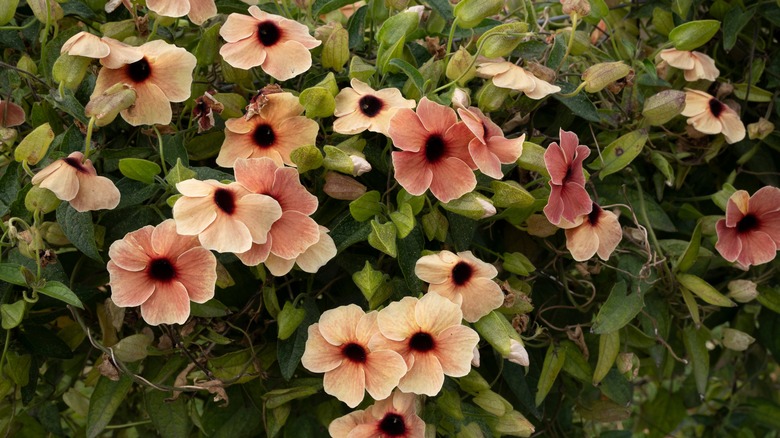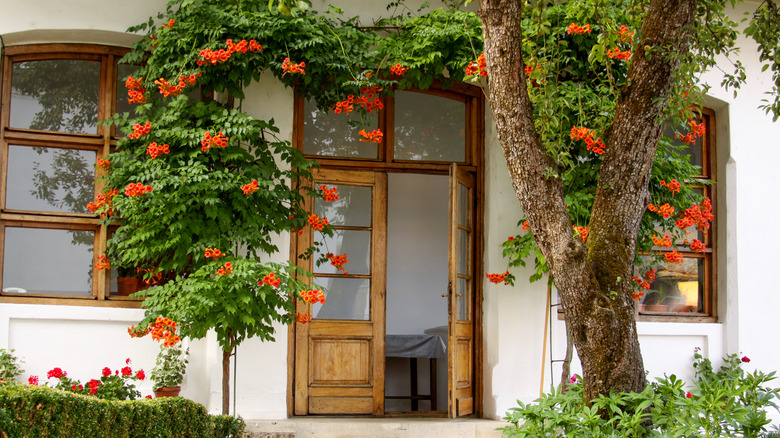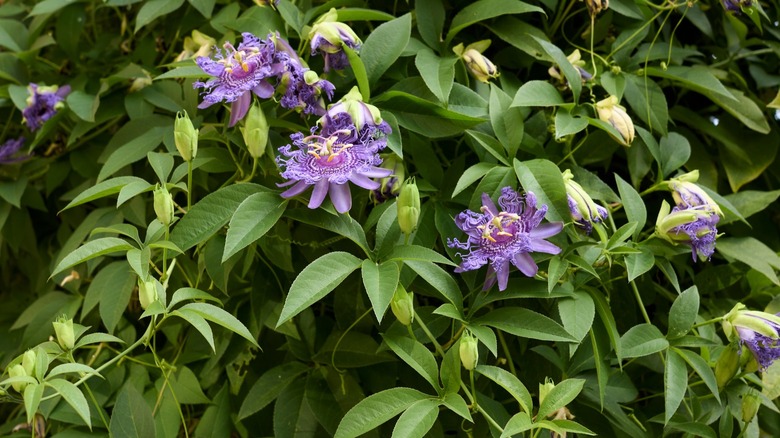15 Climbing Plants You Should Grow On Your Property
Beautifully manicured gardens can be seductive – the apparent planning, talent, and discipline they require engender our admiration and awe. Yet, behind the show, something reductive exists within the lushness, in all the pruning, pulling, and shaping. In contrast, scrambling vines and blooms that cascade from arbor slatting and the tops of stone walls to brush the crowns of our heads and tips of our ears feel effervescent and full of mischievous energy. They climb, and so we must look up, forgetting our feet.
But these symbols of growth and exuberance can't do it alone; they flourish upon structure to the point of obscuring it. Provide them a trellis, a fence, or a lattice screen to hurdle over and through, and they become living sculptures. Climbing plants twine stems around (bines), weave tendrils in and out (vines), wrap roots, or use sticky pads to support their persistent trajectory, according to Ambius. Sunset says some will happily enter doors and windows if invited in.
Many species have wonderfully fragrant blooms that attract pollinators, stunning flowers, and interesting foliage which add intrigue to the landscape or create ideal conditions for drawing feathered friends. Many are easy to care for and thrive in full sun. If they outpace their environment, they can be trained, restrained, and pruned, but you may consider encouraging their wildness just to see what happens.
1. Climbing roses
The rose (Rosa) is appreciated for its beauty, fragrance, and variety. A climbing rose reaches blossoms up to 25 feet skyward on columns, trellises, and fences. Lush growth helps to create privacy while offering a broad palette of flowers from white and sherbet shades to brighter yellow, fuchsia, orange, and red that bloom in spring and throughout the growing season for repeat bloomers per Gardenia. The perennial is deer resistant and a sanctuary for birds. Climbing roses prefer full sun and rich, well-draining soil. Most grow well in USDA zones 4 to 10.
2. Sweet peas
The sweet pea (Lathyrus odoratus) is a hardy annual in USDA zones 2 to 11, flowering from late spring through early fall per the Missouri Botanical Garden. The highly fragrant blooms appear in every color except yellow. Tendrils allow the plants to climb, and they can grow supported as tall as 6 to 8 feet per season. The plant prefers well-draining soil rich in organic matter and regular fertilization, and though it favors full sun, it is not heat tolerant. Lathyrus odoratus should not be confused with the edible vegetable pea and is toxic to humans if ingested.
3. Jasmine
Jasmine (Jasminum) is a genus of shrubs, trees, and climbing vines with more than 200 species that is part of the olive family (Oleaceae). Flowers present in colors including white, yellow, and pink or red less frequently; all blossom with heavily scented star-shaped or tubular flowers. Jasmine blooms from spring to fall and attracts pollinators, according to Gilmour. It prefers full sun to part-shade and moist, well-draining soil. Jasmine can be grown in a container or trained as a shrub or climbing vine; as a vine, it will trellis up to 20 feet, per the North Carolina Extension Gardener Plant Toolbox.
4. Morning glory
The morning glory (Ipomoea purpurea) is a prolific grower prized for its old-fashioned appeal and vivid flowers that greet the day. Per Sunset, it has heart-shaped foliage and trumpet-shaped blossoms of blue, purple, pink, and red from early summer to fall, drawing pollinators and birds. It rambles enchantingly and provides an excellent privacy screen when bolstered by a garden structure, growing up to 30 feet as a perennial in zones 8 and 9 and 15 feet as an annual in zones 2 through 7. The low-maintenance plant prefers full sun and well-draining, moist soil amended with compost.
5. Bougainvillea
Bougainvillea (Bougainvillea spectabilis) is a resilient, heat-tolerant beauty that brightens up any building or arbor. Per BGI Fertilizers, they are vigorously growing year-round bloomers in USDA zones 10 and 11 and when protected from frost in zone 9. They possess thorny, woody stems and a faux flower called a bract, which you'll find in white, yellow, orange, red, pink, or purple; the actual flower is inside these. Supported, bougainvillea vines can reach heights of 40 feet; however, the heavy twining stems must be securely tied to a prop. Prime growing conditions are full sun and loose, well-draining soil leaning toward dry.
6. Scarlet runner bean
The scarlet runner bean (Phaseolus coccineus) is a vegetable commonly known as the pole bean. The pods and seeds are edible; the plant is also favored for its vivid red blossoms — which can be consumed, along with the tender leaves. It's grown as an annual in temperate climates and a perennial in zones 7 to 11. The vine can grow up to 12 feet per season, producing tomato-red flowers from summer to frost that are a magnet for bees, hummingbirds, and butterflies. The plant prefers full sun, consistent moisture, and rich, well-draining soil, via Missouri Botanical Garden.
7. Honeysuckle
Honeysuckle (Lonicera) are ideal ornamental climbers in USDA zones 5 to 8. There is abundant variety in the flowers, which are found in brights or pastels; the bloom season depends upon species. The vine, which grows up to 15 feet, per North Carolina Extension Gardener Plant Toolbox, is an excellent option for a vertical garden feature, while the shrub varieties can be used to create a privacy screen. The native American trumpet honeysuckle is recommended, while Japanese honeysuckle is considered invasive in some regions. The perennial is quick-growing and tolerant, preferring partial shade and moist, well-draining soil.
8. American wisteria
American wisteria (Wisteria frutescens) is beloved by gardeners for its clustered, draping blossoms. Hardy to zone 5, it blooms in spring and again in summer or fall, via the Lady Bird Johnson Wildflower Center. Though lilac is typical, flowers can be pink, white, and blue. Wisteria is so prolific that its impact can be felt on the landscape after a few years. It will grow to 30 feet in height and require a solid support structure. Wisteria is known for having an aggressive growth habit, and certain varieties, such as Chinese Wisteria, are not recommended. American wisteria prefers full sun and moist soil.
9. Clematis
With over 350 species and a range of flower shapes, sizes, and colors, clematis (Clematis) is a favorite climbing or trailing perennial and is nicknamed the "Queen of Vines," per PennState Extension. With options for sun or shade and hardiness for zones 4 to 8, it's an accommodating and stunning option for many gardeners. Bloom time depends on species, with some being repeat bloomers, and sizes vary from a few feet to 40 feet. Hence it's suitable for containers or planting in the ground, and the outlet suggests training on a trellis. It prefers loose, well-draining soil enriched with organic matter.
10. Climbing hydrangea
With ample space, climbing hydrangea (Hydrangea petiolaris) is ideal for gardeners in zones 4 to 7. Derided as a slow grower that will suddenly overtake the landscape — sleeping, creeping, and leaping, as the adage goes, via Gardening with Charlie, it can require patience until established yet will reach up to 50 feet in maturity. The heavy limbs need appropriately sturdy support; according to The Morton Arboretum, its horizontal branching affects a lovely pattern on a wall. Lacy and petalous flowers are highlighted by dense foliage, blooming in late spring to late fall. Partial shade and moist, well-draining soil are preferable.
11. Moonflower
Moonflower (Ipomoea alba) is known as jimsonweed and thorn apple. It hails from the same family as morning glory, and some gardeners recommend combining the evening and dusk bloomers for an animated display. The large white flowers bloom in summer through fall and attract moths and bats. Each generally opens for only a day, and after falling, the site produces sharp thorny pods where seeds eventually develop. Moonflower can exceed heights of 15 feet as a perennial to zone 9, but when grown as an annual, 3 feet is more usual. LocalHarvest recommends full sun and well-draining soil. Moonflower is highly toxic if ingested.
12. Chinese Virginia creeper
Chinese Virginia creeper (Parthenocissus henryana) is a fast-growing deciduous climber hardy in zones 6 to 9, per Plant Lust. The dark green and bronze foliage turns a fiery orange-red and is freckled with berries in autumn, via Royal Horticultural Society. The plant uses tendrils or suckers to climb, yet it will need some assistance getting established. It prefers part to full shade, so it's a good choice for north-facing walls. Regularly moist, rich soil is ideal. The outlet notes a less vigorous growth habit makes it a better option for small gardens.
13. Black-eyed Susan vine
Black-eyed Susan vine (Thunbergia alata) is an easy-care, vigorous grower that House of Hawthornes explains works equally well weaving through obelisks or trailing from containers. Flowers bloom from summer until frost and are usually available in orange or yellow. However, other colors can be grown from seed; they all have the ubiquitous dark eye and attract pollinators. They are cultivated as an annual in cooler climates, where stems can exceed 8 feet of growth in one season; in USDA zones 10 to 12, they can reach twice that. They require part sun, regular watering, and rich, well-draining soil.
14. Trumpet creeper
Trumpet creeper (Campsis radicans) is known as foxglove vine and Devil's shoestring per the Lady Bird Johnson Wildflower Center. In summer, bright orange trumpet-shaped blooms vibrate against dark green leaves, attracting hummingbirds. It's a vigorous and assertive grower up to USDA zone 6. The perennial vine can reach 35 feet, rambling over trellises, tree trunks, and garden walls with aerial rootlets, making it a good solution for erosion management but damaging certain surfaces. The outlet cautions that trumpet creeper is considered invasive in some parts of the country. It prefers full sun and moist, well-drained soil.
15. Passion flower
Passion flower (Passiflora) is a vigorously growing vine with otherworldly blooms that open for only a day from early summer to fall. Flower shades include white and every color of the rainbow except green. According to HGTV, the climber is a favorite for quickly concealing unattractive features. Its growth can exceed 20 feet per year and is best controlled by training onto a wall or structure, while pruning encourages fuller foliage and flower development. Some produce edible fruit. Most varieties are grown as perennials to USDA zone 8, preferring full to part sun, moist, well-draining soil, and an area protected from the wind.
